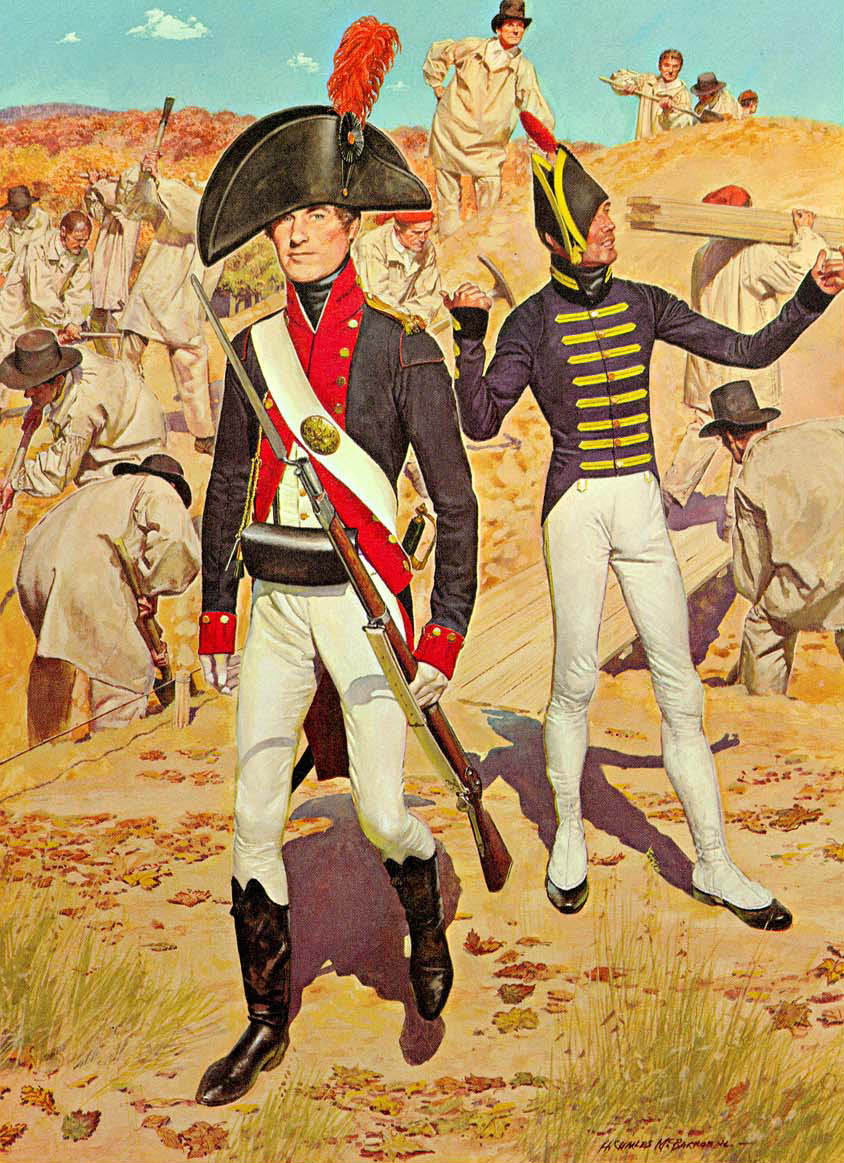|
Charles R. Woods
Charles Robert Woods (February 19, 1827 – February 26, 1885) was a career United States Army officer and a Union general during the American Civil War. He is noted for commanding the relief troops that first attempted to resupply Fort Sumter prior to the start of the conflict, and served with distinction during the war. Early life and career Charles Woods was born in the city of Newark in Licking County, Ohio, the younger brother of William Burnham Woods and the brother-in-law of Willard Warner, both future Union generals.Eicher, p. 581. He grew up on his family's farm in Ohio, where he received a minimal education from tutoring.Warner, p. 571. Woods entered the United States Military Academy at West Point in July 1848, and graduated four years later, standing 20th out of 43 cadets.Eicher, p. 580. He was appointed a brevet second lieutenant on July 1, 1852, and ordered to join the 1st U.S. Infantry Regiment. On July 31 of that year Woods was promoted to the rank of sec ... [...More Info...] [...Related Items...] OR: [Wikipedia] [Google] [Baidu] |
Newark, Ohio
Newark ( ) is a city in Licking County, Ohio, United States, and its county seat. It is located east of Columbus, Ohio, Columbus at the junction of the forks of the Licking River (Ohio), Licking River. The population was 49,934 at the 2020 United States census, 2020 census, making it the List of municipalities in Ohio, 18th-largest city in Ohio. It is most known for having the world's largest basket, former headquarters of the now defunct Longaberger Company. The city is part of the Columbus metropolitan area, Ohio, Columbus metropolitan area. It is the site of much of the Newark Earthworks, a major ancient complex built by the Hopewell culture. The Great Circle portion and additional burial mounds are located in the neighboring city of Heath, Ohio. This complex has been designated as a National Historic Landmark and is operated as a state park by the Ohio Historical Society, Ohio History Connection. History Cultures of indigenous peoples lived along the river valleys for thousa ... [...More Info...] [...Related Items...] OR: [Wikipedia] [Google] [Baidu] |
Regiment
A regiment is a military unit. Its role and size varies markedly, depending on the country, military service, service, or administrative corps, specialisation. In Middle Ages, Medieval Europe, the term "regiment" denoted any large body of line regiment, front-line soldiers, recruited or conscripted in one geographical area, by a leader who was often also the feudal lord ''in capite'' of the soldiers. Lesser barons of knightly rank could be expected to muster or hire a Company (military unit), company or battalion from their manorial estate. By the end of the 17th century, infantry regiments in most European armies were permanent units, with approximately 800 men and commanded by a colonel. Definitions During the modern era, the word "regiment" – much like "corps" – may have two somewhat divergent meanings, which refer to two distinct roles: # a front-line military formation; or # an administrative or ceremonial unit. In many armies, the first role has been assumed by i ... [...More Info...] [...Related Items...] OR: [Wikipedia] [Google] [Baidu] |
1st Infantry Regiment (United States)
The 1st Infantry Regiment is a regiment of the United States Army that draws its lineage from a line of post American Revolutionary War units and is decorated with thirty-nine campaign streamers. The 1st Battalion, 1st Infantry is assigned as support to the United States Military Academy at West Point, New York and to furnish the enlisted garrison for the academy and the Stewart Army Subpost. 2nd Battalion, 1st Infantry Regiment is an infantry component serving with the 2nd Stryker Brigade, 2nd Infantry Division at Joint Base Lewis–McChord, Washington. History Origins On 3 March 1791, Congress added to the Army "The Second Regiment of Infantry" from which today's First Infantry draws its heritage. In September of that year, elements of it and the original 1st Infantry Regiment (today's 3rd United States Infantry Regiment (The Old Guard)), with sizable militia complements, all under the command of General Arthur St. Clair, were sent to the Northwest Indian War of t ... [...More Info...] [...Related Items...] OR: [Wikipedia] [Google] [Baidu] |
West Point, New York
West Point is the oldest continuously occupied military post in the United States. Located on the Hudson River in New York (state), New York, General George Washington stationed his headquarters in West Point in the summer and fall of 1779 during the American Revolutionary War, and later called it "the most important Post in America" in 1781 following the war's end. West Point also was the site of General Benedict Arnold's failed attempt at treason during the Revolutionary War. West Point was first occupied by the United States Armed Forces in January 1778 by Brigadier General Samuel Holden Parsons. Since, West Point has been occupied by the United States Army. It comprises land and water including the campus of the United States Military Academy, which is commonly referred to as "West Point". West Point is a census-designated place (CDP) located in the town of Highlands, New York, Highlands in Orange County, New York, Orange County, located on the western bank of the Hudson Ri ... [...More Info...] [...Related Items...] OR: [Wikipedia] [Google] [Baidu] |
United States Military Academy
The United States Military Academy (USMA), commonly known as West Point, is a United States service academies, United States service academy in West Point, New York that educates cadets for service as Officer_(armed_forces)#United_States, commissioned officers in the United States Army. The academy was founded in 1802, and it is the oldest of the five United States service academies, American service academies. The Army has occupied the site since establishing a fort there in 1780 during the American Revolutionary War, as it sits on strategic high ground overlooking the Hudson River north of New York City. West Point's academic program grants the Bachelor of Science degree with a curriculum that grades cadets' performance upon a broad academic program, military leadership performance, and mandatory participation in competitive athletics. Candidates for admission must apply directly to the academy and receive a nomination, usually from a member of United States Congress, Congr ... [...More Info...] [...Related Items...] OR: [Wikipedia] [Google] [Baidu] |
Willard Warner
Willard Warner (September 4, 1826 – November 23, 1906) was a brevet brigadier general in the Union Army during the American Civil War. He was a U.S. senator from the state of Alabama after the war. Early life and career Warner was born in Granville, Ohio. His great-grandfather was Luke Knowlton, a founder of Newfane, Vermont, and a leader of Vermont during the American Revolution. He graduated from Marietta College, and founded the Newark Machine Works in Newark, Ohio. He was the brother-in-law of future Civil War general Charles R. Woods of Newark. Civil War In December 1861, Warner joined the volunteer army as major of the 76th Ohio Infantry. He served in several battles in the Western Theater, including the Battle of Fort Donelson, the Siege of Corinth, and the Vicksburg Campaign. In 1863 he became lieutenant colonel of the regiment, which he led from Vicksburg to Chattanooga. He served on the staff of William T. Sherman during the Atlanta Campaign as the ins ... [...More Info...] [...Related Items...] OR: [Wikipedia] [Google] [Baidu] |
William Burnham Woods
William Burnham Woods (August 3, 1824 – May 14, 1887) was an American jurist who served as an associate justice of the Supreme Court of the United States. An appointee of President Rutherford B. Hayes, he served from 1881 until 1887. He wrote the majority opinion in '' United States v. Harris'', involving the constitutionality of the Ku Klux Klan Act, and '' Presser v. Illinois'', involving the application of the Second Amendment to the states; both cases adopted a narrow interpretation of the Fourteenth Amendment. He dissented rarely and wrote mostly uncontroversial opinions. Born in Newark, Ohio, Woods received his degree from Yale University. He practiced law in Newark and entered politics, soon rising to be the speaker of the Ohio House of Representatives. A Democrat, he initially opposed the Lincoln administration's policies but supported the Union once the Civil War broke out. He joined the Union army as an officer, participating in a number of battles; after his ... [...More Info...] [...Related Items...] OR: [Wikipedia] [Google] [Baidu] |
Licking County, Ohio
Licking County is a County (United States), county located in the central portion of the U.S. state of Ohio. At the 2020 United States census, 2020 census, the population was 178,519. Its county seat is Newark, Ohio, Newark. The county was formed on January 30, 1808, from portions of Fairfield County, Ohio, Fairfield County. It is List of Ohio county name etymologies, named after the Licking River (Ohio), Licking River, which is thought to be named for the salt licks that were in the area. However, one account explains it as an English pronunciation of the river's indigenous Lenape, Delaware name ''W'li/'ik'/nk'', which means "where the flood waters recede". Licking County is part of the Columbus, Ohio Metropolitan Area, Columbus, OH Metropolitan Statistical Area. Geography According to the United States Census Bureau, the county has a total area of , of which is land and (0.7%) is water. It is the third-largest county in Ohio by land area. Adjacent counties * Knox County, ... [...More Info...] [...Related Items...] OR: [Wikipedia] [Google] [Baidu] |
Fort Sumter
Fort Sumter is a historical Coastal defense and fortification#Sea forts, sea fort located near Charleston, South Carolina. Constructed on an artificial island at the entrance of Charleston Harbor in 1829, the fort was built in response to the War of 1812, which had exposed the inadequacy of existing American coastal fortifications to defend against naval attacks. Fort Sumter was still incomplete in 1861 when it was attacked by Confederate Forces during the Battle of Fort Sumter on April 12, sparking the American Civil War; the fort was severely damaged during the battle and left in ruins. Although there were some efforts at reconstruction after the war, Fort Sumter as conceived was never completed. Since the middle of the 20th century, the fort has been open to the public as part of the Fort Sumter and Fort Moultrie National Historical Park, operated by the National Park Service. History The building of Fort Sumter Named after Continental Army officer Thomas Sumter, Fort Sumter ... [...More Info...] [...Related Items...] OR: [Wikipedia] [Google] [Baidu] |




